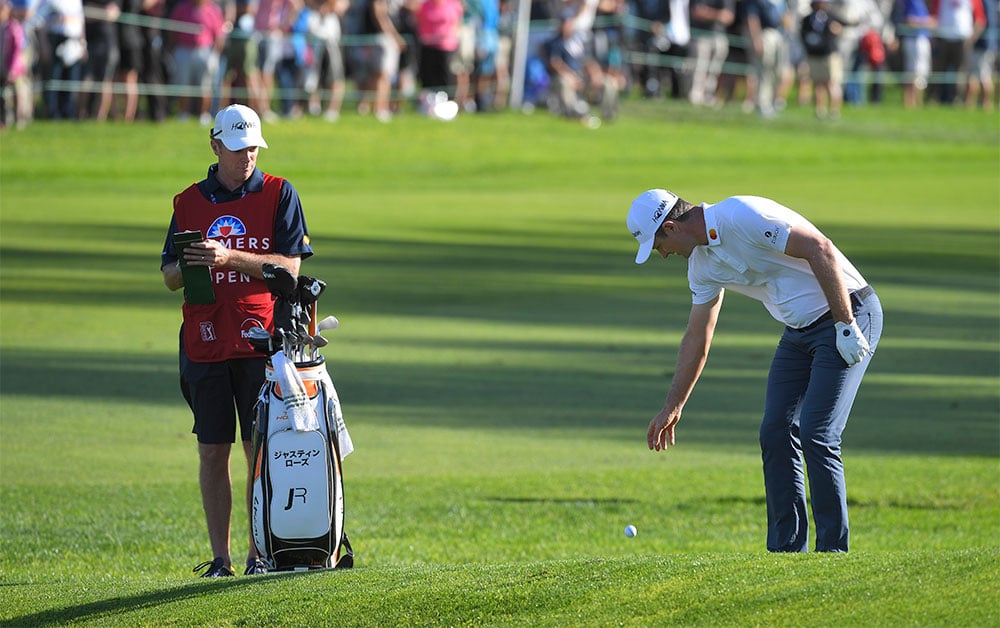So, I’m taking my first drop of the new year: a driver carved into the abyss with more left-to-right spin than a toilet flushed in the southern hemisphere.
I wander down to the hazard markers and take a guess as to the ball’s entry point. I talk my playing partners into a spot that I know to be a good 20 metres beyond where the ball entered, but hey, that’s the luxury of the new rule, social golf and playing with blokes who are always on their phones. A guess will get it done. And those to benefit significantly from this are salespeople who would move their own grandmother to ensure a victory heads their way.
As I work myself into the appropriate dropping position – bent knee, kink in the back – I take some time to ensure that I’ve got strong alignment with my hand, the ball and my knee. Seconds later, it becomes apparent that I have forgotten to activate my glutes and – POW! – my hamstring cramps, which sends my back into spasm and the ball hits the deck and plugs in some unseen sand.

Karma? Or a foolish rule change that sees the need for kinesthetic and plyometric training to execute what was once a very simple golf move accessible to all?
Sadly, there is no poetic licence on the cramp and the spasms. Yes, I’ll admit there was plenty re: the drop, but you get the point. Guessing allows for cunning and sales.
A hamstring torn a decade ago continues to plague me and while I can get the ball out of the hole and put a tee in the ground, I cannot for the life of my still barking pigstring find a comfortable position from which to drop the ball at knee height.
Am I alone? Not likely. Heck, I’m 36. How are you old blokes with your metal and plastic hips going with this?! – Brett Geeves
I understand the need to modernise the game with an eye towards the pace of play, but more often than not people look to take advantage of rules, look for loopholes, and inevitably the best laid plans become problematic; particularly when it comes to pace of play.
Take the new rule that allows the flag to remain in the hole when putting as the perfect example. How much time was the flag actually eating up? I see, and appreciate, the benefit in being able to bomb one with the flag in from 80 feet, which saves you the 55-second walk to the flag for removal and then the amble back. But now we are in a situation where some players are using the “scientific advantage” of having the pin in on downhillers, uphillers, sidewinders and short-range putts. While others aren’t.
It’s what makes Freddie Hart a visionary having penned the song, “Some Do, Some Don’t, Some Will, Some Won’t” back in 1962.
So, by the time you’ve put it in for one, taken it out for another and so on, you’ve actually wasted more time than it took to walk over and take the bloody thing out for everyone!
Want to spend some time sweeping that bunker, hazard (excuse me, “penalty area”) and intricately re-sew the marks those chicken feet have made on the green? Sure, take as much as time as you want; we’ll just take that additional time off when you actually need it – like when you are looking for a lost ball! One that’s likely hiding in the extra-long rough that’s overgrown to protect the course from the technology that is ruining the game.
The simplest way to manage slow play is by actually enforcing the rules on slow groups, and players in particular, as opposed to sending out stern reminders in the monthly club newsletter that no one reads.
Each golf club has them, the tour too. Just don’t be that golfer. You know the one; they wait until it’s their turn to putt to walk to the other side of the hole for a look at the reverse angle, then the side angles, then slowly match the thick black line on the ball with their read on break and speed, to then walk back behind for a 17th look while playing partners are burning holes in them with the evil eye for being that one. The selfish one.
All of that looking can be done on approach to the green and while everyone else takes their putt.
Please, if everyone promises not to be that one, and clubs promise to penalise players with strokes added to their score and not waffle fear mongering about pace of play, then the R&A and USGA won’t have to sell bulk fluff and nonsense as modernisation of the game.




